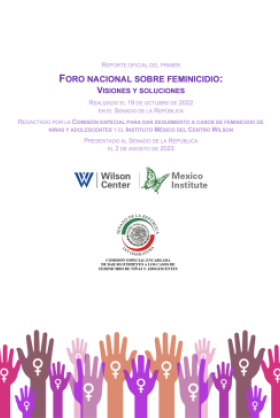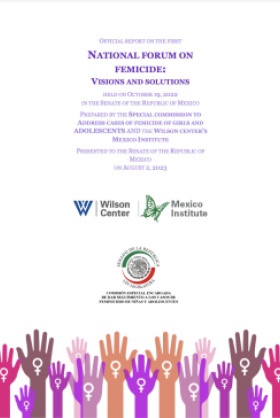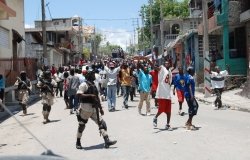10 Ways to Reduce Violence in Mexico
This Expert Take identifies 10 punctual policy recommendations for reducing violence and containing crime in Mexico.

This article identifies 10 punctual policy recommendations for reducing violence and containing crime in Mexico. Each of these recommendations were drawn from the results of “What works in reducing community violence,” USAID’s latest study, and by comparing it with evidence and analysis of violence-reducing strategies in Mexico. The goal is to push Mexico’s violence reduction efforts back on track, particularly now that murder rates have once again begun to rise.
Mexico is more violent now than a year ago. In 2015, murder rates were up at least 11% from the prior year, a sharp contrast with previous years when, since at least 2012, murder rates had diminished consistently.
Though violence prevention programs are quite common, more and better information is urgently needed to guide social investment targeted at reducing community violence. That is why this new report and the conversation about it hosted by the Wilson Center’s Mexico Institute and Latin American Program in Washington, D.C. is so important. In the report, Harvard professors Thomas Abt and Christopher Winship did what many had tried before: analyzed decades of empirical evidence to identify the most effective policies to reduce violence.
To find state-of-the-art of research on violence deterrence, USAID’s study reviewed 43 previous literature reviews, including more than 1,400 studies of different violence prevention and reduction interventions. Table 1 shows the types of interventions that were analyzed. To provide a framework for the analysis, these were classified in three different approaches: (1) place-based (those that target violent geographic locations), (2) people-based (focused on violent individuals), and (3) behavior-based (concentrate on behavior that tends to trigger violence, such as carrying firearms, selling illegal drugs).
Table 1.
Approach
Strongly effective
Mixed, modest or moderately effective
Non or negatively effective
Place-Based
Hot spots policing, broken window policies, urban renewal, CPTED, neighbor watch, poverty de-concentration.
Community oriented-policing.
People-Based
Focused deterrence, cognitive therapy.
Problem-oriented policing, procedural justice, vocational training, mentoring, school or family-based programs, restorative justice, aftercare programs.
Juvenile curfews, electronic monitoring, boot camp, scared straight.
Behavior-based
Comprehensive gun violence reduction, drug courts and treatment.
Gun enforcement and legislation, gang behavior regulation and prevention.
Gun buybacks, drug enforcement, comprehensive gang reduction.
What works to reduce crime and violence?
The most immediate and important lesson that USAID’s study leaves for Mexico is a simple but powerful one: crime prevention is the most effective when it is very precisely targeted.
The interventions that proved to be the most effective to reduce violence are not those that target entire urban areas or even specific neighborhoods, but those that directly target the small networks of individuals already engaging in or most likely to engage in violent behaviors. We need to stop thinking that crime will be reduced when we concentrate efforts on eliminating “violent neighborhoods” or controlling “violent places”. Instead, we need to realize that violence is much more focalized, concentrated in a few areas within a neighborhood, and conducted by a few people inside a group. Even within a gang of 20-30 members, it is only 3 or 4 who are “shooters,” so identifying those individuals and focusing deterrence efforts on them is much more effective than generally increasing attention to the entire community in which they live. It is not always easy to identify or engage these individuals, but policymakers must understand that in order to be effective, violence reduction efforts must be extremely targeted.
Among interventions focused on deterring particular individuals or behaviors, four are the most effective:
• Focused deterrence are policies that use sanctions and rewards to stop offenders and offending groups to engage in violence. About 9 of every 10 of these interventions work, reducing homicides from 34% to 63% where they are implemented.
• Cognitive behavioral therapy are policies that use psychological techniques to train the young in controlling their emotions, impulses and reactions to anger. Amazingly, just by training previous offenders with these techniques, recidivism can be diminished up to 52%.
• Targeted gun violence reduction are policies focused on deterring behaviors that encourage the use of guns. It requires trusted enforcement institutions to send clear messages that are not “stop all crime” or “leave the gang,” but “stop shooting, stop killing.” Strategies like gun buybacks or anti-gun legislation are mostly ineffective.
• Drug treatment and drug courts reduce violence much more than aggressive drug enforcement, which tends to increase it. Drug wars promote violence, drug treatment the opposite, by reducing recidivism among violent criminals with substance abuse issues.
USAID’s findings leave Mexico with at least 10 lessons on how to make crime prevention more effective. In the following section, each of these lessons is described:
What would be the 10 most important recommendations to reduce violence in Mexico?
1. Stop thinking crime prevention is about “polygons.” Mexico’s main program of crime prevention, the PRONAPRED, operationalizes most of its interventions geographically, at “polygons.” Polygons are small territorial units that were selected because of their criminal characteristics. Yet, they are still too big. A better approach will get rid of the idea of polygons, or select them just as a first step for later identifying people and behaviors that could become dangerous. Mexico must stop thinking on large violent areas, and move towards a more micro vision.
2. Develop local intelligence capabilities. To be able to identify people and behaviors, rather than geographical units, developing local allies is a must. It is people inside the communities and local NGOs that best know where and when violent events occur and who partakes in them. A program to professionalize or create insider agents would be much more effective to target crime and violence than any form of centralized top-down policy.
3. Emphasize cognitive therapy over improvement of public space. The most common activity to prevent crime implemented in Mexico is workshops of abilities and values, yet the one that receives the most resources is urban interventions. Urban interventions like the improvement and creation of public space have been associated with reduced crime and violence, only in Medellín, Colombia, but little evidence exists that shows this is replicable. Instead, evidence seems to show that behavioral interventions are strongly effective and much cheaper. Indeed, urban interventions have the political benefit of being visible, perhaps that is why it seems to be so popular.
4. Take advantage of Mexico’s Ministry of Education’s programs. Crime prevention programs implement thousands of workshops to help at-risk populations to control their emotions, impulses and reactions to anger. Yet, most of these programs are not homogenized in its curricula, and devote most of their time to vocational training – a type of cognitive training that is the least effective but the easiest to implement. Crime prevention programs should take advantage of the homogenized curricula of cognitive workshops that have already been developed, at the federal level, by the Ministry of Education’s programs, particularly ConstruyeT. The fact that PRONAPRED and ConstruyeT do not talk to each other only shows how uncoordinated federal agencies are when thinking about crime prevention.
5. Give enough funding to crime prevention programs. The budget of the main program for crime prevention in Mexico, the PRONAPRED, has been cut in 25% over the last year. It already had a pretty small budget of 150 thousand dollars per year, to one of 111 thousand. If Mexican authorities are serious about crime prevention, the budget of PRONAPRED must increase or, at least, remain consistent over time.
6. Better a war against the violent use of guns, than a violent war against drugs. The drug war, understood as the capture and prosecution of top-level traffickers, increases violence because it destabilizes drug cartels. Yet, the creation of (a) policies to inhibit the flow of illegal weapons into the hands of criminals, and (b) drug courts and drug treatment, is much more effective to reduce violence. Mexico must stop its rhetoric of a broad drug war, and substitute it for targeted policy against guns, drug courts and drug treatment. Drugs must be addressed as a health issue more than an enforcement one. Policy to deter gun use must be as focused in high risk individuals as possible. Gun exchanges and the creation of legal frameworks seem to be much more effective.
7. Implement a Mando Único with a local vision. Mexico is currently discussing a police reform that could centralize police departments into a single statewide department (i.e. Mando Único), eliminating or weakening the autonomy of local police departments. The reform will only be effective to reduce violence if the new centralized police is centralized in its procedures, but not in its vision. The new Mando Único needs to operate as a local police department would, identifying criminal problems and creating ad hoc intelligence for solving them. Instead, if Mando Único creates a single federal police with little contact with the locals, the reform may backlash.
8. Evaluate Impact. Most evaluations of whether Mexican policies to prevent crime are effective come from international papers, not from local evaluations of impact. This impedes the use of evidence to design policies. Funds must be allocated to create impact evaluations, and most importantly, to make their findings public and replicable.
9. Consider crime prevention part of Mexico’s comprehensive judicial reform. Most efforts to reform Mexico’s justice system emphasize judicial and legislative changes, making crime prevention programs simple, poorly funded appendices. If Mexico is to take seriously its policies of violence reduction, it must consider them part of the judicial system as a whole, training police and local judicial institutions in prevention techniques.
10. Forget about “community policing” and “broken window theory.” Both of these policies have been widely promoted as effective ways to reduce crime but available evidence suggests they have, at best, a modest impact. First, community policing is a policy that creates partnerships with residents to reduce crime. Such polices are effective in increasing citizen satisfaction and police legitimacy, but not reducing violence. Instead, a more interesting approach would be to focus on hot spots and particular individuals. Second, intolerance of all crime (broken windows, or disorder policing) often creates tensions within communities while only acting as a modest deterrent. Focused deterrence, created through a carrot and stick approach, rather than an enforcement only strategy, is more promising.
For Mexico to reduce violence, the above recommendations must be complemented by six “elements of effectiveness” shared by the most effective interventions. These elements are: (1) focus on those most at risk for violence, (2) prevent violence before it occurs, (3) increase legitimacy of enforcement institutions, (4) pay careful attention to program implementation, (5) have a well-defined and understood theory of change, and (6) partner with critical stakeholders.
Much is still to be evaluated and discussed in order to fully understand what works, and what does not, to reduce violence in Mexico. These 10 recommendations are a first step in trying to create a healthy debate on these topics.
**Viridiana Rios holds a Ph.D. in Government from Harvard University, and is a Global Fellow at The Wilson Center. She is an expert in Mexico’s subnational economy, citizen security and rule of law. Before joining the Wilson Center, Viridiana was CEO of México ¿Cómo Vamos?, a Mexican think tank, senior adviser to Mexico’s Minister of Finance, and to Mexican President’s Spokesman. She has a weekly column at Excelsior, and regularly publishes her academic research in peer-reviewed journals.
Approach | Strongly effective | Mixed, modest or moderately effective | Non or negatively effective |
Place-Based |
| Hot spots policing, broken window policies, urban renewal, CPTED, neighbor watch, poverty de-concentration | Community oriented-policing |
People-Based | Focused deterrence, cognitive therapy | Problem-oriented policing, procedural justice, vocational training, mentoring, school or family-based programs, restorative justice, aftercare programs | Juvenile curfews, electronic monitoring, boot camp, scared straight |
Behavior-based | Comprehensive gun violence reduction, drug courts and treatment | Gun enforcement and legislation, gang behavior regulation and prevention | Gun buybacks, drug enforcement, comprehensive gang reduction |
About the Author

Viridiana Rios
Columnist, El Pais; Instructor of US-Mexico politics at Harvard Summer School

Mexico Institute
The Mexico Institute seeks to improve understanding, communication, and cooperation between Mexico and the United States by promoting original research, encouraging public discussion, and proposing policy options for enhancing the bilateral relationship. A binational Advisory Board, chaired by Luis Téllez and Earl Anthony Wayne, oversees the work of the Mexico Institute. Read more











